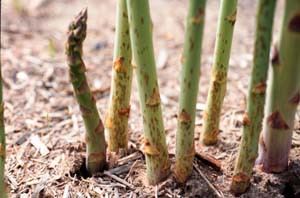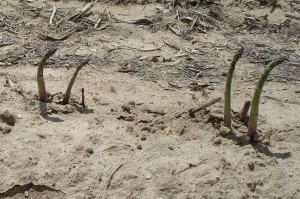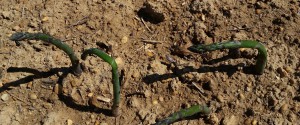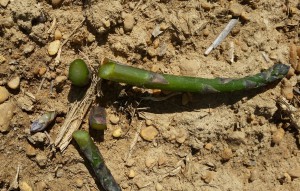- Late blight has been reported in Florida and South Carolina on tomato. To track the season-long progress of Late blight in the US please visit (http://usablight.org/)
- There has been isolated reports of cucurbit downy mildew on watermelon and cucumber in southern Florida. To track the season-long progress of cucurbit downy mildew in the US please visit (http://cdm.ipmpipe.org/)
Archives for April 2016
Vegetable Disease Briefs – 4/15/16
Controlling Purple Spot in Asparagus
Purple spot, caused the soil-borne fungus, Stemphylium vesicarium, can cause problems during cool, wet spring weather. Symptoms, just like its name, include numerous, sunken oval-shaped spots on spears during the harvest season and more importantly on ferns and stalks during the summer months as long as conditions are ideal for its development. Often, purple spot will disappear as quickly as in appears on spears during the spring production season depending on the weather conditions.

Purple spot in asparagus (Photo by Mary Hausbeck, Michigan State University)
Heavy purple spot infection during the summer will lead to premature defoliation which will decrease carbohydrate reserves for the next production season. Control of purple spot can be difficult because of management issues (i.e., the need for fall mowing and/or removing, burying, or burning of old fern material in the field) and because fungicides can’t be applied during the harvest season. Growers who had pre-mature defoliation issues last year may expect problems this spring. Controlling purple spot begins with preventative fungicide applications during summer and fall by reducing infections to ferns and stalks. Weekly scouting and timely fungicide applications once fern stalks are full size should be done. Apply and rotate azoxystrobin at 6.2 to 15.5 fl oz 2.08F/A or chlorothalonil at 2.0 to 4.0 pt/A.
Organic asparagus growers, as well as conventional growers, need to take appropriate preventative measures to help reduce inoculum loads by completely removing, or by chopping and burying old fern material at the end of each growing season. Remember, any plant material that is infected and left to overwinter in the field may act as a source of inoculum the next growing season. For more information on organic asparagus production please see ATTRA’s Organic Asparagus Production.
Cold Injury: Disease Control in Peach Orchards without Fruit
Cold injury to peach flowers and primordial fruit occurred during the evening of April 5-6 as temperatures dropped below freezing. At the Rutgers Agricultural Research and Extension Center, air temperatures first dropped below 32ºF at 10 pm Tuesday and remained below freezing until 9 am Wednesday morning. The lowest temperatures of 22 to 23 ºF occurred for four hours between 4 and 7 am. The average low temperature during the entire 12 hour cold period was 25.5 ºF. [Read more…]
Spear Damage in Asparagus
Spear damage in asparagus can be caused by diseases such as Phytophthora spear and crown rot and purple spot. However, other environmental factors during the spring can damage spears as they emerge from the soil.
| Freeze Injury – About 10 days ago temperatures dipped well below freezing for a night or two, and combined with the higher than normal temperature this spring, some asparagus fields that had already started to produce spears were hit with injury. Affected spears will be bent/distorted and begin to breakdown and rot (Fig. 1a).
Cutting frozen spears will show the discoloration of the spear caused by the freeze (Fig. 1b). |
 Fig. 2. Wind damage of asparagus spears. Notice how all spears are pointed in the same direction |
Wind – Periods of heavy winds during emergence will cause spears to bend.Winds can cause one side of the spear to dry out quicker than the other causing the spear to bend and point in the direction of the prevailing wind. An asparagus planting is suffering from wind damage if most of the bent spear heads in the bed are pointing in the same direction (Fig.2). |
Organic Production: Suppressing Soil-borne Pathogens
Pathogens such as Fusarium, Pythium, Phytophthora, Thielaviopsis and Rhizoctonia that cause pre- and post-emergent damping-off can cause serious problems in organic (and conventional) transplant production.
The key to controlling and/or suppressing damping-off pathogens with biological controls is keeping the biological populations high and continually present on root surfaces of the host, and by following good cultural practices. [Read more…]
Understanding Damping-off Pathogens in Transplant Production
Damping-off is caused by a number of important vegetable pathogens and is very common during transplant production and early-spring. Damping-off can kill seedlings before they break the soil line (pre-emergent damping-off) or kill seedlings soon after they emerge (post-emergent damping-off). Common pathogens that cause damping-off include Pythium, Phytophthora, Rhizoctonia and Fusarium spp.
It is extremely important to know which pathogen is causing the damping-off problem and which fungicide to properly apply.


